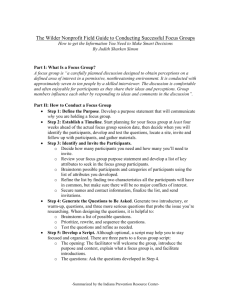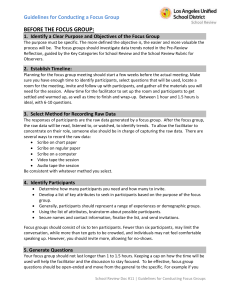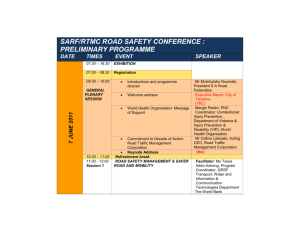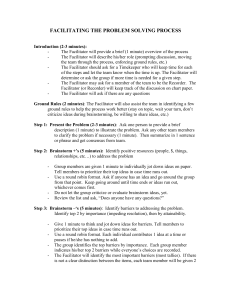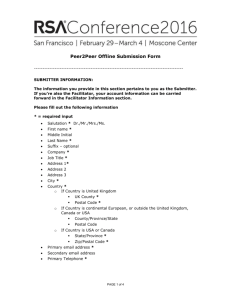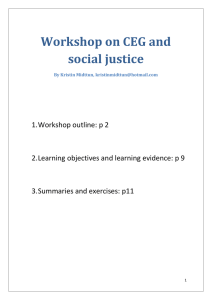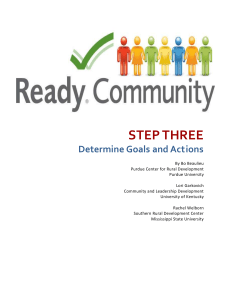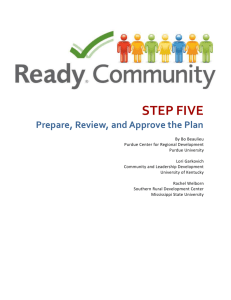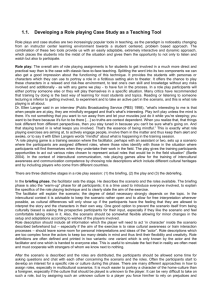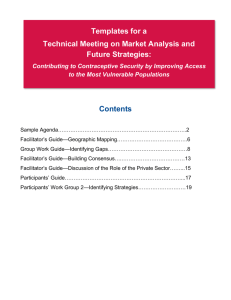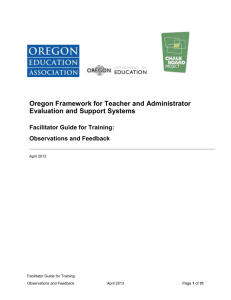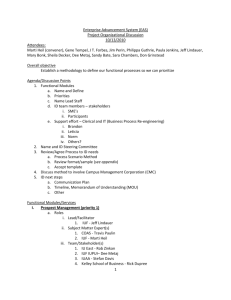Population estimates
advertisement
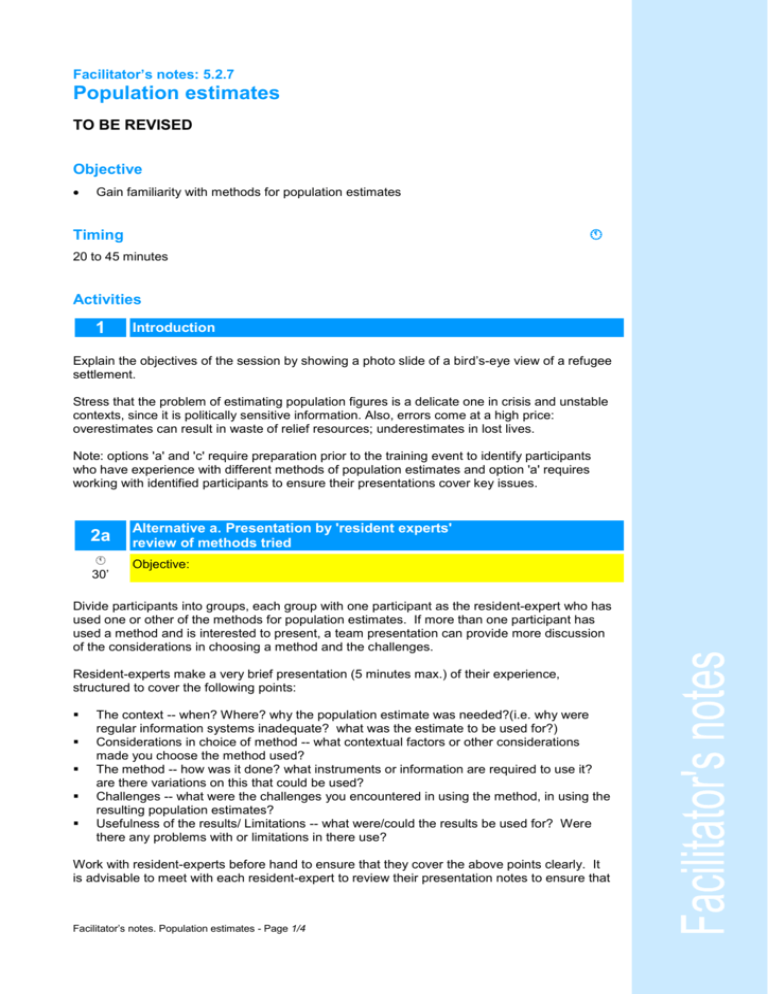
Facilitator’s notes: 5.2.7 Population estimates TO BE REVISED Objective Gain familiarity with methods for population estimates Timing 20 to 45 minutes Activities 1 Introduction Explain the objectives of the session by showing a photo slide of a bird’s-eye view of a refugee settlement. Stress that the problem of estimating population figures is a delicate one in crisis and unstable contexts, since it is politically sensitive information. Also, errors come at a high price: overestimates can result in waste of relief resources; underestimates in lost lives. Note: options 'a' and 'c' require preparation prior to the training event to identify participants who have experience with different methods of population estimates and option 'a' requires working with identified participants to ensure their presentations cover key issues. 2a Alternative a. Presentation by 'resident experts' review of methods tried 30’ Objective: Divide participants into groups, each group with one participant as the resident-expert who has used one or other of the methods for population estimates. If more than one participant has used a method and is interested to present, a team presentation can provide more discussion of the considerations in choosing a method and the challenges. Resident-experts make a very brief presentation (5 minutes max.) of their experience, structured to cover the following points: The context -- when? Where? why the population estimate was needed?(i.e. why were regular information systems inadequate? what was the estimate to be used for?) Considerations in choice of method -- what contextual factors or other considerations made you choose the method used? The method -- how was it done? what instruments or information are required to use it? are there variations on this that could be used? Challenges -- what were the challenges you encountered in using the method, in using the resulting population estimates? Usefulness of the results/ Limitations -- what were/could the results be used for? Were there any problems with or limitations in there use? Work with resident-experts before hand to ensure that they cover the above points clearly. It is advisable to meet with each resident-expert to review their presentation notes to ensure that Facilitator’s notes. Population estimates - Page 1/4 the presentation give participants enough information to understand the method and be able to make a choice on relevance for their own context. After each presentation, ask whether there are any participants who could or could not envision using such a method in their working context (currently or in the event of an emergency) and why/ why not? Use this discussion to highlight considerations and limitations in using methods for population estimates. Use option b below to cover any methods or issues not covered by resident-experts. 2b Alternative b. Presentation by facilitator: review of methods 20’ Objective: This option should be chosen where few or no participants have ever had to do population estimates in this manner and are not necessarily very strong in quantitative data collection methods (thus unlikely to be able to come up with the options in group work). Use core content sheet "Population estimates" and overheads to make a presentation covering the various methods and highlighting when/where each can be used and the challenges/limitations for each. 2c Alternative c. Group work & plenary discussion case exercises on choice of population estimate methods 45’ Objective: This option can be used where the facilitator judges that participants will be able to identify possible methods, either because enough participants have worked in emergencies and are to some degree familiar with these methods, or because they are strong in monitoring and evaluation methods and could envisage adaptations. Alternatively, the core content sheet "Population estimates" can be distributed and groups can be invited to consult it as they try to complete the exercise. Divide participants into groups of 5-8. Assign one of the following scenarios to each of the groups. (Distribute corresponding case exercise sheets to participants in each group. TO BE DEVELOPED) Ask groups to record the answers to their questions on flipchart paper fo presentation to plenary. Give groups 20 minutes. Scenario A -- Task #1 You are facing the beginning of a dramatic crisis of internal displacement of a population from one region. Camps are spreading out along the border of that region near the capital city, and every day more IDPs are moving to the area. No data are available. You need to provide population estimates to guide basic immediate response as well as the response in the coming months. How can you provide an estimates of the population in the settlement? What will be the limitations to this data? What references will you check these estimates against? Scenario A -- Task #2 You are facing the beginning of a dramatic crisis of internal displacement of a population from one region. Camps are spreading out along the border of that region near the capital city, and every day more IDPs are moving to the area. No data are available. You need to provide Facilitator’s notes. Population estimates - Page 2/4 population estimates to guide basic immediate response as well as the response in the coming months. How can you provide an estimates of the population on the move? What will be the limitations to this data? What references will you check these estimates against? Scenario B You are working in a context of ongoing civil war that dates back 10 years. The last census dates back to 15 years ago. Populations in the southern most affected region have been repeatedly displaced since then. In this southern region, food distributions are being made to the 15 major cities and towns under siege. Vast areas of the regions are no longer inhabited due to prolonged fighting and landmines causing insecurity. Other fairly arid regions are sparsely inhabited by disperse family farms and villages. Donors are no longer willing to provide assistance in the next year without some clear population estimates. What methods could be used to make a population estimate the towns and cities under siege? What methods could be used to make a population estimate for the other areas of the region? What references will you check these estimates against? Scenario c Last night there was a huge earthquake (9 on the Richter scale) in the hilly regions of country X. The epicentre was directly in the District capital. There are several towns close by and then subsistence farming in areas surrounding. You need to make a rapid estimate of the population potentially affected in the next few hours to get a preliminary estimate to an interagency meeting on contingency supplies for emergency response. How would you come up with a population estimate? What assumptions would you make? What references will you check these estimates against? Presentation to plenary Invite each group to very briefly present their proposals to plenary. (If any groups have used the same case and questions, invite the subsequent group to add anything new or different to complement the first group's presentation.) After the presentation of each case, invite all participants to consider: Is this the best method? What considerations make it so? (including what instruments or information are required to be able to use this method?) What could be the challenges in using the method? What might be the limitations in using the results? Use an adapted presentation as in option 'b' or hand out and review core content sheet "Population estimates" to fill in any gaps. 3 Conclusion If you have used options 'b' or 'c', invite participants to identify method they could envisage using in the most likely emergency scenario in their context and why it would be the most suitable. Use this discussion to re-emphasise considerations and limitations in using methods for population estimates Facilitator’s notes. Population estimates - Page 3/4 Materials Flip charts and markers Handouts Population estimates Overhead Population estimates Facilitator’s notes. Population estimates - Page 4/4

